Menu
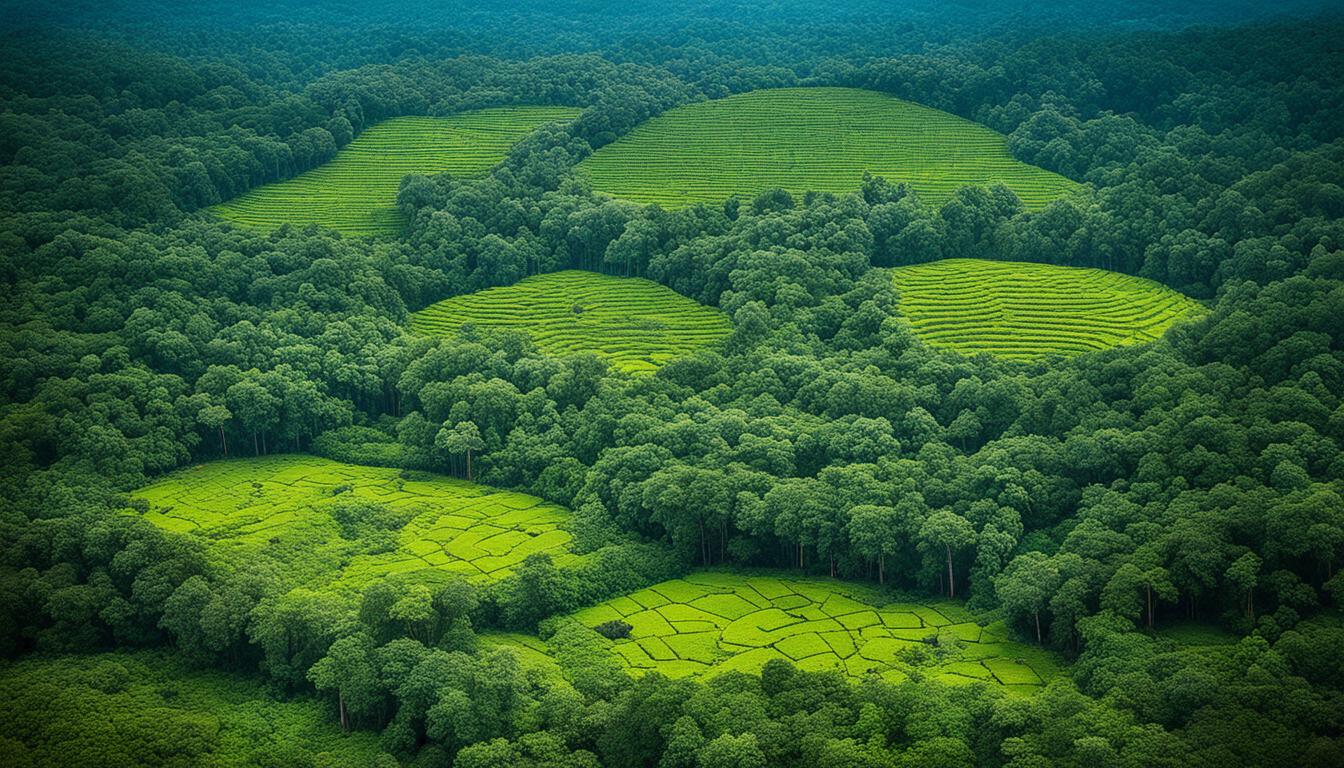
Did you know over 3,000 fires hit the Amazon in September? This was a significant drop of 55% from August. And compared to 2018, there was a 39% decrease. These numbers show the Amazon still faces a serious threat, needing urgent care to save it.In a speech at the UNGA, Brazil’s President Jair Bolsonaro downplayed the Amazon’s global importance. He also said Brazil doesn’t have serious environmental problems. But environmentalists are worried, saying urgent steps are needed for conservation. This debate highlights the importance of agroforestry in finding solutions for the Amazon’s problems.
Agroforestry changes how we manage land. It’s vital in the Amazon because it mixes trees, crops, and animals. This mixing boosts ecological health and farm productivity, safeguarding key ecosystem services.
Agroforestry blends trees, crops, and animals in a farm. In the Brazilian Amazon, farmers test various mixes, including local and new crops. Even though it’s not widely used in the Amazon, mostly for raising cattle, agroforestry shows promise for both making money and protecting nature.
Agroforestry is key in the tropics. It helps the soil, captures carbon, and more. In the Colombian Amazon, these systems are boosting soil health. But, farmers need more help, like lower interest rates and better research support.
For agroforestry to truly succeed, it needs adaptable plans, focus on selling crops, strong technical advice, and good markets. Even though there are challenges like bad roads and little market info, the possible gains are huge. These include more wildlife and other economic activities.
| Challenges | Solutions |
|---|---|
| Inadequate infrastructure | Improved market access and infrastructure |
| High commercial interest rates | Subsidised credit programmes |
| Lack of market intelligence | Enhanced marketing assistance and intelligence |
The Amazon Rainforest is a vast sanctuary of life, home to around one million people and over three million plant and animal species. It’s vital for keeping our planet diverse, as it holds about 10% of all known life forms. Covering 2.3 million square miles, it’s a huge home for many. It also plays a key role in fighting climate change by absorbing and storing lots of carbon.

This amazing rainforest is not just about animals and plants. It helps regulate our climate too by absorbing and storing massive amounts of carbon. The 93 Petagrams (Pg) of carbon it stores are super important for our planet. For example, in 2000, mangroves around the world stored about 6.4 billion metric tons of carbon.
What’s more, the Amazon helps in many ways that most people don’t see. It regulates water, makes soil, and recycles nutrients. But sadly, all these benefits are at risk due to massive deforestation.
Deforestation is a big threat to the Amazon. This is mainly due to agriculture and logging. In the past fifty years, nearly a fifth of the Brazilian Amazon has been lost. That’s about 300,000 square miles, with cattle pastures being a big problem.
Illegal logging makes matters worse. In fact, 94% of it in Brazil is done without permission. There are also issues with new roads, mining, and oil extraction harming the forest. Recent political decisions haven’t helped much either. For instance, extending the BR-163 highway was a bad move that’s worried many people.
| Country | Deforestation (2001-2021) | Primary Cause |
|---|---|---|
| Brazil | 300,000 square miles | Agriculture |
| Bolivia | 25,700 square miles | Agriculture & Policy |
| Colombia | 19,000 square miles | Logging & Development |
| Peru | 14,000 square miles | Agriculture |
| French Guiana | 300 square miles | Development |
People everywhere are starting to realise how important it is to stop deforestation. With less fires in September, efforts seem to be working. But, the fight is far from over. It’s vital we all come together to protect the Amazon Rainforest.
Sustainable agriculture is vital for saving our rainforests. It helps stop the harm caused by farming that does not consider the environment. Today, such farming leads to 80% of the cutting down of the Amazon rainforest. This makes it clear we urgently need better ways that protect nature and still produce food.
Leaders and farmers are turning to sustainable agriculture to solve this issue. They are moving away from usual farming to methods that act like natural environments. This way, we can keep more plants and animals alive and make the land healthier. This helps not only the natural world but also the people living in rainforest areas.
There’s proof in the Brazilian Amazon. There, blending cocoa trees with cattle has boosted what farmers earn by 31%. Also, these methods can lock away around 11 tons of carbon from the air each year. This is important as cattle farms in the area release 340 million tons of carbon yearly.
| Aspect | Conventional Agriculture | Sustainable Agriculture |
|---|---|---|
| Deforestation Contribution | High (80%) | Low |
| Soil Health | Depleted | Restored |
| Carbon Sequestration | Minimal | High (11 tons per acre) |
| Economic Viability | Short-term | Long-term (31% revenue increase) |
Yet, starting these sustainable farming methods is not easy. Making big changes costs a lot at first, and not all farmers know what to do. Plus, getting money to start is hard, which stops many from trying this new approach. Tackling these issues needs help from government, non-profits, and business. They must support farmers with advice and money to make this kind of farming grow.
Agroecology is key in the Amazon, promoting sustainable land management. It uses polyculture systems, where different crops and trees grow together. This helps the land produce more, supports many species, and stands strong against changing climates.
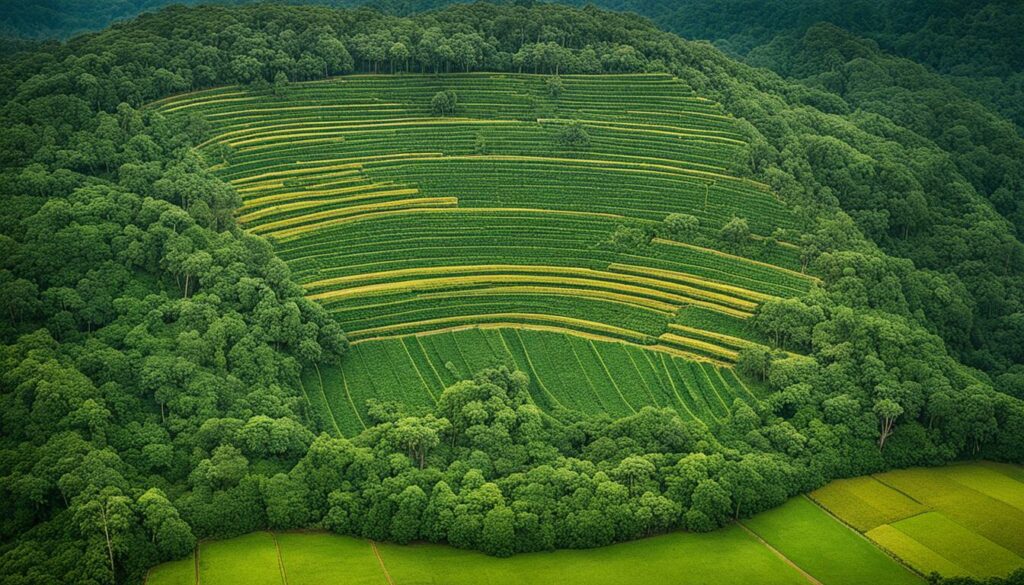
Agroforestry’s polyculture systems mimic natural diversity. At Olhos D’Água farm, various trees and crops are grown together. This approach produces top-quality goods, like cocoa, in a way that’s kind to the environment. It builds back biodiversity and improves the soil, showing the power of agroecology in the Amazon.
Agroforestry’s aid in carbon sequestration is significant. It captures carbon in the soil and in plant life, combating climate change. Studies show these practices are great for cutting atmospheric carbon. They are a big help in reaching climate goals.
| Statistic | Value |
|---|---|
| Reduction in Amazon Fires (September) | 55% from August, 39% from 2018 |
| Amazon’s Biodiversity | 10% of the world’s known biodiversity |
| Mangrove Carbon Sequestration (2000) | 6.4 billion metric tons |
| Colombian Tree Cover Loss (2000s) | 2,220k hectares |
| Carbon Emissions by Colombian Deforestation | 1,000Mt of CO2 |
The lower Amazon fires and vast biodiversity here show how vital agroforestry is. It’s crucial for a healthy tropical forestry, boosting farm yields, and major carbon storage. These methods offer hope for a greener planet.
Olhos D’Água is deep in the heart of the Amazon. It’s a prime example of how agroforestry can fight deforestation. It also shows how sustainable farming can thrive. This area was once only for logging. Now, it’s a symbol of regrowth and green farming.
The main goal at Olhos D’Água was to fix the land with trees and crops. They wanted to stop deforestation’s harm while helping people live off the land. It changed from a cut-down place to a lush area full of life.
At Olhos D’Água, using agroforestry has done wonders. By planting many kinds of crops and trees, they’ve made good food. But they’ve not hurt nature much in doing it. They’ve saved local plants and animals, cutting down less forest too.
They worked with lots of local farmers, which made a big difference. More farmers are now keeping their land as it should be. They’re taking care of the environment better than before.
All in all, Olhos D’Água is a great example of what smart farming can do. It can make bad land good again. It can also help people live well. By doing this, it helps nature and people at the same time.
Agroforestry projects lead the way in reviving old farming ways in indigenous communities. They are key to making sure there’s enough to eat in a sustainable manner. This way, six tribes in the Brazilian Amazonia, about 7,400 people, can grow various foods without harming the environment. By doing this, their food supply stays strong even when facing hard times.
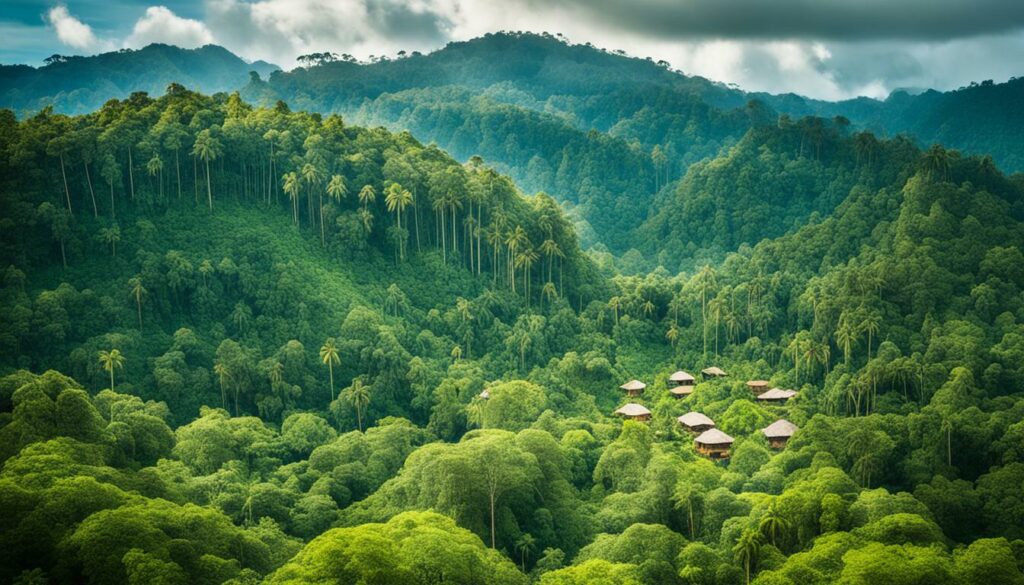
A good example is the Asháninka people in Peru. They faced big problems when heavy rains from El Niño flooded their lands in March. This flood broke or washed away the crops and homes of 300 families. It showed how much these communities need help during disasters.
Before this, the Kemito Ene group was doing really well. They sold lots of cacao each year and aimed to sell even more. Even though the pandemic slowed them down, they plan to sell even more by 2023. This would mean they can take care of themselves better. However, they still need help from the Rainforest Foundation UK.
After the flood, the group started a plan to get back on their feet. They cleaned up, got new seeds, and started growing new plants in nurseries. But, the water took a long time to go away, making their recovery slow. It showed how important it is to have a strong plan to bounce back after such events.
The flood also showed that waiting for national help isn’t enough. Indigenous communities felt the government could do more to help. This is where agroforestry and keeping traditional ways come in. They help these communities stand strong and do better when problems hit.
In the Amazon, farmers are using smart methods to keep the land productive. They blend tree growing with traditional crop farming. This way of farming is like nature’s own. It brings many good things, like saving the soil and making more plants and animals thrive.
Farmers in the Amazon are making the soil better to grow food. They use things like lime to balance the soil’s acidity. This has been especially helpful for crops like açaí. It makes the soil more fertile, allowing them to grow more food than before.
By taking care of the land, farmers can keep growing crops for many years. These good methods help small farms stay healthy and keep up with the demand for food. They are key in places where forests have been cut down.
With agroforestry, farmers plant trees alongside their crops. This mix makes farming more able to withstand problems and helps the soil get better. In the Amazon, special trees like Jaca and some types of Annonaceae are used. They give fruits and other useful things, making the farm more balanced.
In Bolivia, this method is very popular on family farms. These farms are small but make up a big part of the farming land. In Brazil, growing these mixed crops near cities has brought both money and helped nature. It shows how farming smartly can be good for both people and the planet.
| Region | Integration Practice | Outcome |
|---|---|---|
| Amazon | Agroforestry with diverse species | Improved soil health, enhanced biodiversity |
| Ecuador & Peru | Smallholder farming with lime application | Soil pH correction, sustained productivity |
| Bolivia | Integration of tree and annual crops | Economic resilience, land restoration |
| Brazil (urban municipalities) | Tropical fruit farming | Economic gains in non-beef revenues |
Across the Amazon and in many areas, farming is showing it can be kind to the earth and still give plenty. These ways of farming make local economies stronger and help nature thrive.
Agroforestry in the Amazon meets several conservation strategies challenges. These stem from differing environmental policies and the desire for quick economic wins. The Amazon area is critical, harbouring a million indigenous people and over three million plant and animal species.
It is vital to find strong agroforestry challenges solutions. These will help preserve biodiversity and fight deforestation.
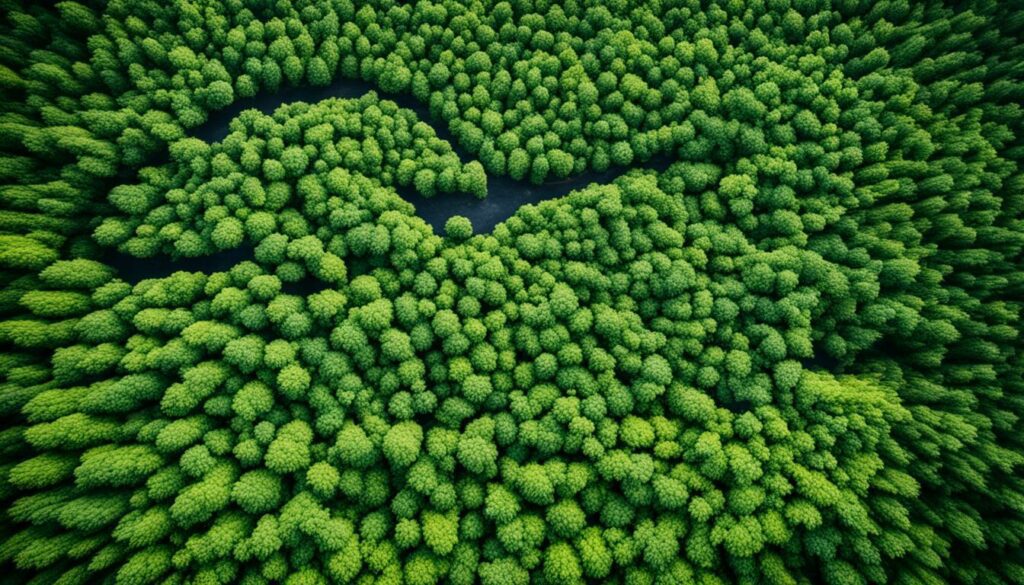
Educating people is key to combat these issues. This includes locals, decision-makers, and companies. They need to learn about the benefits of caring for the land long-term.
Amending laws to back conservation strategies is crucial for agroforestry’s success. It should blend economic growth with eco-friendliness.
In the Amazon, agroforestry is not the top choice yet. Still, some farmers are trying out various mixes of crops and trees. These trials show that agroforestry can make a big difference.
However, making agroforestry work in the Brazilian Amazon comes with hurdles. Things like tough business costs, poor infrastructure, and a lack of research support stand in the way. But, if governments, companies, and the public work together, these agroforestry challenges can be defeated.
| Challenge | Mitigation Strategy |
|---|---|
| High commercial interest rates | Subsidised loans and credits for agroforestry ventures |
| Adequate infrastructure | Investment in energy, roads, and port facilities |
| Insufficient research support | Enhance public sector research and extension services |
Learning from successes like the Oceanium project in Senegal can teach us a lot. With international help, agroforestry efforts in the Amazon could do even better. They could meet environmental goals while helping people.
For agroforestry to succeed, it must be flexible, focused on adding value to products, and well-supported technically. It should strive for easy access to markets and less need for outside money. These steps can overcome agroforestry challenges and lead to green and profitable land use in the Amazon.
Government policies greatly affect agroforestry in Brazil. They set the rules for these sustainable farming systems. In recent years, Brazil’s environmental policies have faced a lot of criticism for favouring short-term profits over long-term benefits for the environment.
The Amazon is very important both ecologically and culturally. However, policies focus more on making money quickly rather than on protecting the Amazon for the future.
The current legal system in Brazil is often blamed for causing deforestation. It does this by easing the rules that protect the Amazon. For example, it makes it easier to clear land for farming, which can harm the environment.
One such farming method is shifting cultivation. This can be good for a while but harms the land over time. It also doesn’t do enough to prevent destructive techniques like slash-and-burn farming.
It’s very important to stand up for the environment and push for better laws. This means supporting reforms that keep our forests safe and encourage sustainable ways of farming, like agroforestry. Looking at how other countries protect their nature can also give Brazil good ideas.
By making policies that support agroforestry, Brazil can fight against deforestation. This kind of farming is good for the environment and can even help keep our air clean. Governments, environmentalists, and regular people all need to work together. We must ensure that the Amazon thrives for the children of tomorrow.
Looking at agroforestry in the Amazon and Senegal shows us some key similarities and differences. Both places benefit a lot when it comes to saving nature and trapping carbon. Agroforestry helps by keeping more trees, which stops nature from being destroyed and makes the soil better.
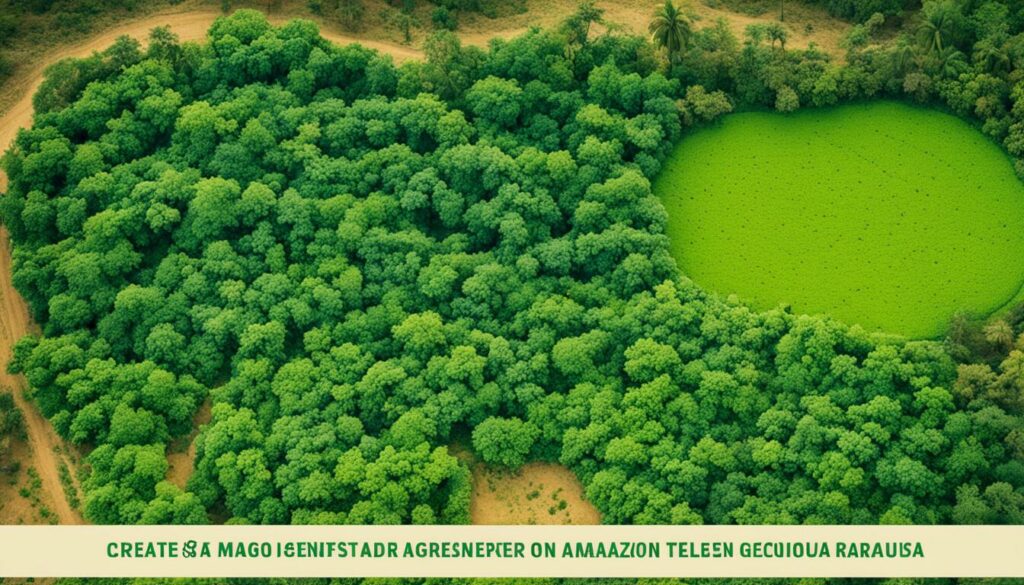
In the Amazon, agroforestry makes up for some of the bad things that happen when we cut too many trees. Companies in Colombia have seen that these ways of farming make the soil stronger. This is checked using the Soil Management Assessment Framework (SMAF). Over in Senegal, replanting mangroves helps a lot by storing a huge amount of carbon. This is a bit like what the Amazon does.
How the government and the public think about agroforestry is very important. Senegal shows us that working together can do wonders. The government, NGOs like Oceanium, and local people have made many efforts to tell people about protecting nature. A result of their work is planting 79 million trees in one area. They’ve also fixed up nearly 8,000 hectares of mangroves. This is huge. In the Amazon, things are harder because the rules change a lot. This often messes with their plans to protect nature properly.
| Region | Environmental Benefits | Policy Approaches | Public Awareness |
|---|---|---|---|
| Amazon | Biodiversity preservation, carbon sequestration, enhanced soil quality | Inconsistent policies, fluctuating government support | Growing but varied across regions |
| Senegal | Mangrove restoration, significant carbon sequestration | Collaboration between government, NGOs, and local communities | High due to concerted policy and NGO efforts |
To sum it up, although there are similar good sides to both Amazon and Senegal’s work on agroforestry, policy and how much people know about it make all the difference. This highlights the need for clear, solid plans and making sure more people understand why caring for nature is key. Good policy and spreading the word are key to making agroforestry work well for both places.
NGOs are now key in boosting agroforestry and pushing for eco-friendly methods. They work across policies and practical projects. Their goal is to help nature heal and communities thrive. With a joint effort from all involved parties, including locals, governments, and global groups, agroforestry is getting a lot of attention.
In places where governments can’t do enough, NGOs fill the gap. Take the Brazilian Amazon. There, farmers need help to use agroforestry systems due to tough lending rates and poor infrastructure. NGOs offer vital support. They bring seeds, aid research, and rally the community. They also push for fairer and greener forestry rules.
Oceanium’s work in Senegal is a shining example. They’re working with the locals to bring back mangroves and fight environmental problems. This is not just about nature. It’s also making life better for people. NGOs like Oceanium show how civil groups can make a big difference in saving the planet. They enhance both nature and local lives.
The future of agroforestry in the Amazon looks bright. It combines sustainable growth with protecting nature. However, most of the Amazon’s land is used for cattle and other farming. This causes problems because it leads to deforestation, endangering many species.
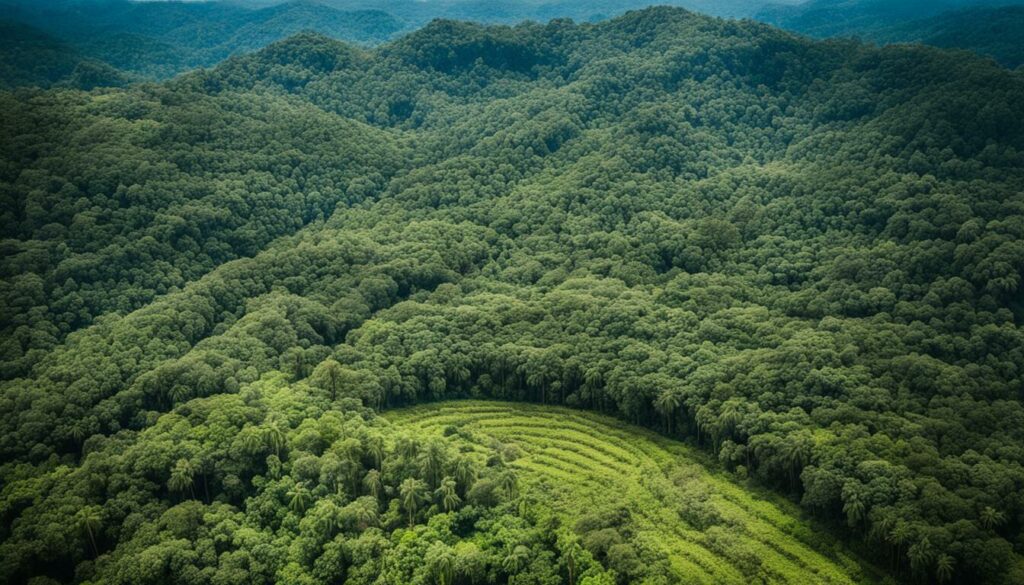
One big challenge is to make agroforestry more popular. This is hard because of financial problems. For example, high interest rates make it tough for farmers. Also, there are not enough government loans to help them start.
To really make a difference, we need better roads and markets for agroforestry products. Researchers and experts must listen more to what farmers need. This helps everyone work together better. It also means agroforestry can grow and protect the forests.
In countries like Colombia, there’s hope. They’re using programs that are working well. These programs encourage planting trees and protect the forest. But we need more proof that these plans are really stopping deforestation.
One big need is more tree seeds and young trees. Making agroforestry work well involves smart planning and help with selling the products. If farmers get the right help, they won’t need as much money from others to get started.
| Factor | Brazil | Colombia | t
|---|---|---|
| Tree cover loss (2000s) | – | 2,220kha | t
| CO2 Emissions (deforestation) | – | 1,000Mt | t
| Deforestation rate | – | 0.38% per year | t
| Support programmes | Inadequate | ‘Visión Amazonia’ | t
| Research Input | Lacks farmer input | Supported by SINCHI | t
We can make the future of agroforestry in the Amazon great. This means focusing on certain key areas. Better roads and funding are important. So are strong groups of farmers. With hard work, the Amazon can stay safe for the future.
Agroforestry in the Amazon greatly helps in taking carbon out of the air. This process is key in fighting climate change. The new forests in the west of the Amazon capture carbon 60% better than those in the east. This means that for every hectare of forest, more carbon is locked away in the new forests in the west.
By keeping the 2017 secondary forests, about 19.0 Tg of carbon could be stored each year until 2030. This is vital for Brazil’s goal of reducing carbon emissions by 2030. It shows how smart farming and conservation can make a big difference in the fight against climate change.
The way we use the land can have a huge and lasting effect on the environment. For example, fires and cutting down trees time and again can slow down new tree growth by 55%. But if we protect the land, carbon storage can grow by 8%. Today, we already have 294 Tg of carbon safely stored in the Amazon’s young forests.
Agroforestry doesn’t just save the land, it also catches more carbon. This makes it a key part of our long-term plan to battle climate change.
Agroforestry’s role in locking up carbon demands a rethink in global policies. If we protect our secondary forests, we could save 19.0 Tg of carbon every year. This shows why the whole world needs to get behind efforts to keep these lands safe.
Agroforestry could change the way we handle climate change worldwide. Tackling the issue in tropical forests, which hold more than half of Earth’s land carbon, is vital. But this can only happen with strong, global support.
| Region | Regrowth Rate (Mg C ha−1 yr−1) | Impact of Disturbance (%) |
|---|---|---|
| West Amazon | 3.0 ± 1.0 | -20% |
| East Amazon | 1.3 ± 0.3 | -55% |
To make a real difference, we need better checks on how farming affects the environment. Protecting forests in Brazil is important for the whole planet’s climate health. So, the laws and agreements made about this matter are critical.
Agroforestry helps a lot in saving different species, making ecosystems stronger. It brings in many different plants and animals. This benefits the health and balance of many tropical areas, like the Amazon.
The Amazon area is key, hosting over three million species and about one million people. It’s a vital place with a lot of biodiversity, about 10% of all known species.
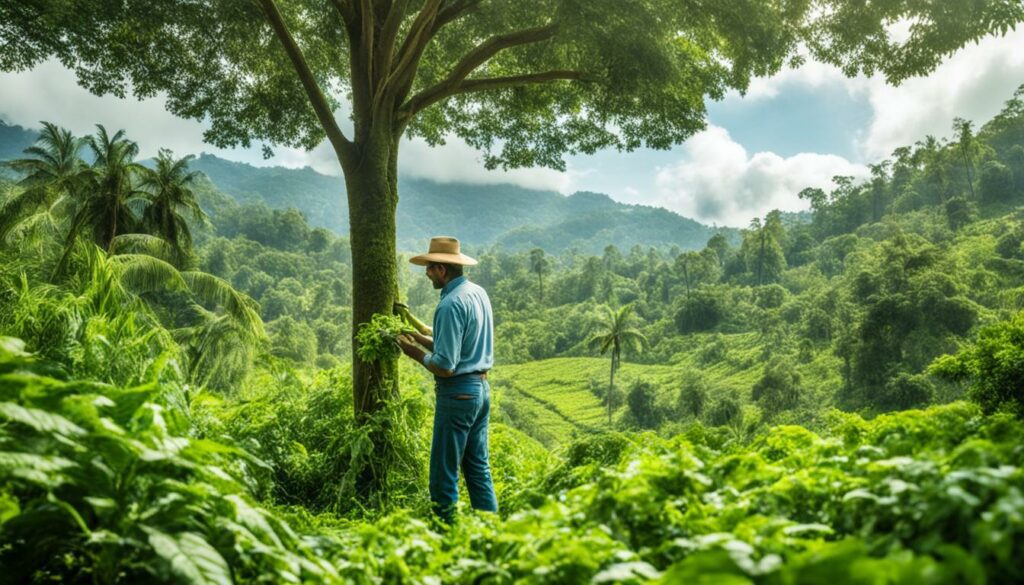
In Colombia, where 10% of the Amazon is, people are working hard to preserve biodiversity. The Colombian Amazon has lost a lot of trees in the past 50 years. This area’s efforts are very important for protecting nature.
Colombia’s work under the National Strategy for Reducing Emissions from Deforestation and Forest Degradation (ENREDD+) and the Paris Agreement shows its strong commitment. The country’s National Development Plan aims to fight climate change. It plans to make the economy less harmful to the earth.
| Country | Amazon Coverage (%) | Tree Cover Lost (kha) | CO2 Emissions (Mt) | Annual Deforestation Rate (%) |
|---|---|---|---|---|
| Colombia | 10 | 2,220 | 1,000 | 0.38 |
| Brazil | 60 | 75,000 | N/A | N/A |
Agroforestry is not only helping in the Amazon. Senegal, for example, is planting millions of trees. This kind of work is also improving mangrove areas.
Another example is in Casamance, where they managed to restore 35,000 acres of mangrove forests. This shows how agroforestry can help protect nature worldwide.
Mixing different plant and animal species helps keep our environment more diverse. A 2008 study in *Conservation Genetics* found we can keep unique plant genes safe by collecting seeds from local forests. This proves agroforestry can help farming while keeping our environment rich in biodiversity.
Agroforestry is a key way to help with saving rainforests. It combines farming and tree planting in a way that helps the environment. This method stops the land from being cleared for farming and helps local people make a living.
In countries like Ecuador and Peru, many small farmers use agroforestry. They grow crops such as coffee and cacao to sell worldwide. These farmers help heal lands that were once deforested while also looking after the land well, which cuts down on clearing forests.
In Bolivia, a third of the farmable land is owned by small families. These families have turned deforested lands into farms that can also grow trees. This way of farming is a good example of how to turn back deforestation and help save the rainforest.
Agroforestry is great for making jobs and supporting families. In Brazil, many farmers near cities grow foods and fruits. They get most of their money this way. Agroforestry lets these farmers grow a lot of different crops without needing to cut down more trees.
The açaí berry is a perfect example. It’s very important in the Amazon, even more than soy and maize. Growing it the agroforestry way helps meet big demands and helps local people make a living. Growing more açaí in such ways is a good plan for jobs and for saving the rainforest.
Agroforestry is good for both the planet and for people. It helps keep forests safe while giving local farmers work and food. This method points to a future where we protect the forest and help communities.
In summary, studying agroforestry in the Amazon shows us how caring for the environment can go hand in hand with growing sustainably. This effort started in 1998 with the Pilot Program to Conserve the Brazilian Rain Forest. It has brought back lost ecosystems by using a mix of native and new crop plants. Even though it covers less area than cattle farms and slash-and-burn fields, agroforestry has a big future.
The Amazon faces tough challenges in becoming more agroforestry-friendly. This includes high interest rates for loans and poor infrastructure like energy, roads, and ports. The government’s support and help for farmers could also be stronger. Overcoming these hurdles is key to agroforestry’s success.
To make agroforestry thrive and benefit all, we need to do many things. We must improve the roads, provide better seeds, and give stronger support from the government. By embracing these sustainable farming methods, we can build a balanced future. A future where taking care of our planet and making a living work together well.
Agroforestry mixes trees, crops, and animals for ecological and economic benefits. It protects the Amazon’s services and helps locals without cutting down trees.
It uses polycultures to mimic nature and restore biodiversity. This method supports sustainable farming, easing the need to clear more forest.
The Amazon struggles with deforestation from agriculture and logging, made worse by weak laws. It’s also losing its rich variety of life and ability to store carbon.
Sustainable farming and agroforestry mend the environment and help people. This way, conservation doesn’t hinder but helps with human progress.
Polyculture farming enhances biodiversity and soil quality, producing top-notch goods. It also traps carbon, fighting climate change.
Olhos D’Água flipped logging land into diverse farming, thriving with crops like cocoa. It shows farming and conservation can work together positively.
It revives their farming traditions, safeguarding their way of life and land. Organisations like Instituto Amazonas are making big positive differences for many.
Agroforestry fixes soil and mixes trees with crops for a natural boost. This approach makes farming better for the environment and more productive.
Problems include laws that don’t match, greedy leaders, and little education. Solving this needs working on laws, teamwork, and teaching about conserving.
Current rules in Brazil put money first, not the Amazon’s future, weakening protection. Better policies are crucial to save the forest and grow sustainably.
Both aim to save wildlife and reduce climate change. Senegal excels at uniting all to protect its mangroves, showing others how to act against the crisis.
NGOs lead in supporting agroforestry and nature. In Senegal, Oceanium’s work shows how important joining forces is for a green future.
It depends on managing growth and nature well. Successful agroforestry projects prove it can be a win-win, saving forests while helping people.
It’s good at taking out carbon from the air. By cutting carbon, agroforestry aids global efforts to fight climate change.
Agroforestry guards the Amazon’s diverse life, making nature stronger. It builds homes for many, ensuring ecosystems stay healthy and balanced.
It gives people better, forest-friendly jobs, reducing the need to cut trees. This makes it a solid choice for both the environment and local life.